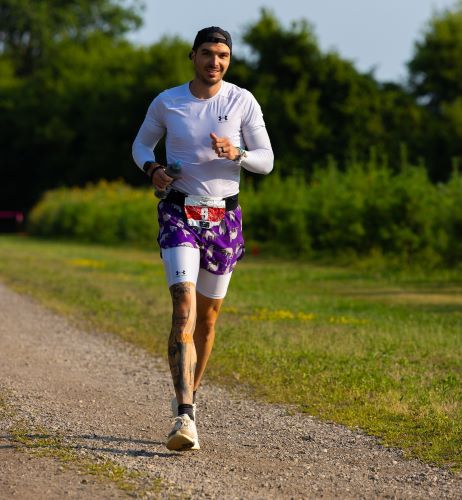
Michael Rouleau has no issue with pushing his body to the limit.
Where exactly that limit sits remains to be seen.
Rouleau is among the large group of Sudbury residents who has been smitten by the lure of long-distance running. He is also among a much smaller group who is drawn to a very particular niche within the spectrum of distance running.
“The backyard ultra format really, really interests me,” explained the 31 year-old who grew up playing hockey – but was never a runner. “I really like the mental aspect of it. There’s obviously a huge physical component to it, but the mental is different than other races.”
The brainchild of American endurance race designer Gary Cantrell, the backyard ultra was launched some 15 years ago based on a relatively simple context: in order for runners to cover a 100-mile stretch in a period of 24 hours, they needed to average 4.167 miles (6.71 kms) an hour.
Adding an interesting twist to the various endurance races that existed at the time, the backyard ultra format dictates that runners cover ONLY that 6.71 kilometre loop in the course of one hour, but then reconvene on the start line, again, at the start of the next hour, and do it all over again and again, until there is one last man or woman standing.
The race format also dictates that in order to win a race, a participant must complete one more loop than the second last person (the “assist”) – but then must call it quits. Runners are not allowed to proceed any further than the one singular lap by which they claim victory.
With that all as clear as mud, let’s throw in the wild notion that in capturing the recent Persistence Backyard Ultra in London (ON), Rouleau would complete this pre-determined circuit for 43 consecutive hours, compiling a grand total 288.53 kms in a span of slightly less than two days.
There is clearly plenty to unravel in this challenge.
“Distance events are all challenging and different in their own way, but it’s the resilience aspect of the backyard that appeals to me,” said Rouleau. “How far can I go? And the problem solving aspect – it’s one big puzzle. Nutrition, support crew set-up, hydration, everything.”
And to think this all started from a combination of two seemingly independent occurrences: 1) the urge to head out for a short run to relieve some Covid-related stress and 2) the happen-chance stumbling across a You Tube video that featured runners completing a 160km race – something Rouleau assumed at the time was more or less “fake news”.
As he made the progression that so many have, from lap around the block to 5km, 10km, half marathons, marathons and such, Rouleau found himself introduced to the inaugural BB Backyard Ultra at Kivi Park last October. Twenty-five hours later, the member of the Greater Sudbury Police Services department had won his first race – and was hooked.
The calendar year of 2025 was not at all about adding hardware to the trophy-case.
“I was not that interested in winning, this year; I was interested in finding my limit,” said Rouleau. “In order to find your limit, you need to be in a race with someone who can run further than you.”
For the northern Ontario gentleman, those “someones” turned out to be Harvey Lewis (former world record holder – 108 hours) and Scott Snell (2024 Big’s Backyard Ultra champion – 88 hours), folks who were competing in Ohio (March) and Washington D.C. (May) respectively.
“I learned so much from those two experiences,” said Rouleau, bumping his race totals up to the 30-31 hour range – but still well off what he just accomplished in London, a performance that currently qualifies him to represent the country at the Backyard Ultra World Team Championships in 2026 (though the qualifying period runs through until next August).
“If it’s a point to point race and I am running against someone like that (Lewis or Snell), I will see them for the first two minutes of the race and never see them again,” explained Rouleau. “In the backyard format, whether you are relatively new to this or the best in the world, you are all kind of running a similar pace.”
“In the middle of the night (in Ohio), when there were maybe only ten of us left, I got to spend two to three hours running with Harvey Lewis, alone, and picking his brain. It was an amazing, amazing experience.”
Rouleau had assumed that for those who had more than doubled his totals, the introduction of muscle soreness and sleep deprivation clearly did not happen until long after he was falling victim to these hindrances to his run. What he discovered what exactly the opposite.
“Guys like that feel the pain at basically the same time I do; they have just learned to manage it,” he said. “If you are willing to hang on long enough, the pain doesn’t get any worse. You just have to be willing to tolerate the pain and keep putting one foot in front of the other.”
(Rouleau obviously distinguishes between pain and injury – but that whole discussion is the topic of a completely separate column)
As much as this seems like the ultimate personal challenge, Rouleau is quick to acknowledge a couple of team aspects to the undertaking. As he alluded to earlier, the “assist” runner is key – though not one enters a race hoping to take on the mantle.
“If you want to go far, you need other people to also go far,” he said. And given the on-going temptation to call it quits, the support staff performs far more than just logistically necessary tasks.
“I need someone who holds me to the game plan – and I have a pretty detailed plan.”
A friend and his brother would provide the support in London, while his parents were on hand for the entirety of his 30-hour race in Washington. When Michael Rouleau looks to defend his title in Sudbury on October 4th, he will have more options at his disposal.
Expect him to select whoever is likely to push him to his limit – wherever that may be.
According to BB Backyard Ultra race organizer Andre Dumais, there are about 12 openings or so remaining to fill the maximum 200-runner field for the upcoming event. For more information, Dumais can be reached at andred@vianet.ca







